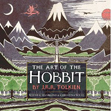The Art of the Hobbit by J.R.R. Tolkien

The Art of the Hobbit. J.R.R. Tolkien. Wayne G. Hammond and Christina Scull, eds. Harper Collins, 2011. 144 p., £25.00 or $40.00 (hardcover). ISBN-13: 978-0547928258
Reviewed by Edward J. Kloczko
[This review originally appeared in Mythprint 49:6-7 (#359-360) in June-July 2012.]
Wayne G. Hammond and Christina Scull have assembled just over 100 drawings in this very handsome art book. Most of them have been published before but this time the printing and the colors are absolutely perfect. And some, if not all, of the never-seen pictures are really worthwhile. My favorite among these is No. 51, the “Entrance to the Elvenking’s Halls” with large trees in the foreground.
Tolkien was a gifted illustrator, even if he had difficulty with the Human (and Hobbit) body. In the 90’s I had the opportunity to talk with Jean Giraud dit Moebius, a French comics artist. I believe he is also quite known in the U.S. He was very much impressed by Tolkien’s art and especially by Nargothrond (illustration No. 54 in the book).
The book is divided in twenty-two sections, with an Introduction and an Afterword. Bag-End Underhill, The Hill: Hobbiton, A Letter to Bilbo, The Trolls, Rivendell, Thror’s Map. The Misty Mountains, Beorn’s Hall, Mirkwood, The Elvenking’s Gate, The Forest River, Lake-town, The Front Gate, Conversation with Smaug, Smaug Flies around the Mountain, Death of Smaug, The Lonely Mountain and the Long Lake, Wilderland, The Hall at Bag-End, Binding Designs, Dust-jacket Art, Portrait of Bilbo. Each section has a short commentary; however, there is no thoughtful analysis of the drawings or Tolkien’s technique. Hammond and Scull deal mostly with how the pictures relate to the text, and are sometime a little too descriptive for my taste. The Introduction is a welcome resume of Tolkien’s work, if a little too diluted in style.
For those who (like myself) are into anything Elvish coming from Tolkien, the Letter to Bilbo from Thorin done in tengwar is a must! It has even some new, never before published, tehtar, or diacritical signs. Regarding the name Esgaroth written in tengwar on p. 114, I wouldn’t be so sure that Tolkien wrote Ezgaroth as Hammond and Scull presume. That name looks strange in itself. The first tengwa, shaped like a big c, stands for an e, and was transformed by Tolkien into a Latin E by drawing a central bar to it. The mode is not the same as the one used in Thorin’s letter, where for e a dotted j is used (like in the word ‘unnecessary’), and the tengwa c stands for an o (like in ‘Thorin’, at the start of the letter). I wonder if the strangely shaped áze is not in fact just a badly drawn silme.
The three runes that Gandalf scribbled on Bilbo’s doors are much more readable than before, on picture No. 3. These, using Tolkien’s names, are the ‘birch’ rune (for Bilbo?), the ‘man’ rune or maybe the ‘day’ rune (for Door?), the last one is ‘ing’, the diamond rune, which however does not appear in the list of Anglo-Saxon runes used by Dwarves as provided by Tolkien. [It strikes me that B is more likely for Burglar. What do readers think? — Editor.]
At the very end of the book (p. 144), the call numbers of the drawings in the Bodleian Library and at Marquette University have been included, which is very welcome and will be helpful to scholars. Do I really have to tell you that you can buy it with your eyes wide shut, as the saying goes in French?

